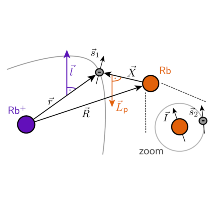In the ultracold regime of laser-cooled atomic gases, a giant Rydberg atom can bind to a nearby ground-state atom forming an ultralong-range Rydberg molecule. The exotic molecular bond arises from the faint interaction of the Rydberg electron with the ground-state atom. Since their discovery in Stuttgart about a decade ago, ever more details of the internal molecular structure have been explored both experimentally and theoretically. For example, the molecule’s internal spin structure is intimately linked to the quantum nature of the spin-dependent electron-atom interaction, which may occur in a total spin singlet or triplet configuration.
The situation is even more intriguing, when the electron-atom system interacts resonantly in a non-zero orbital angular momentum channel. Then the angular momentum of the electron-atom scattering process may couple via spin-orbit interaction to the molecular spin arrangement. This intrinsic spin-orbit coupling for resonant p-wave interaction has for a while refused experimental observation. Only recently, evidence thereof was reported for Rubidium S-state molecules (PRL 123, 073003 (2019)). Now, in a collaboration between groups from Ulm, Hamburg, and Suttgart direct evidence of spin-orbit dependent electron-atom scattering was observed for P-state Rydberg molecules. The Ulm experiment revealed a characteristic multiplet substructure induced by spin-orbit coupling in the resonant p-wave scattering channel. This work, published in Phys. Rev. Research, provides a new important cornerstone zooming in on the full complexity of ultralong-range Rydberg molecules.


